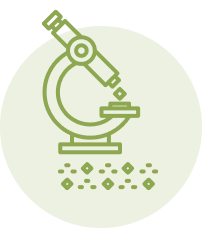At Earth Science, our mission is to create a better earth from the ground up. For this reason, we are a big advocate for testing your soil. After all, testing your soil is the first step toward improving it! But how do you test your soil? Below are some general guidelines that will help you to test your soil.
How to Gather Soil Samples
When testing your soil, it’s important to make sure that the soil sample to be tested is representative of the entire area. For the average lawn, taking a sample of 6 to 8 areas will help to get a representative sample. Collect a sample by removing a small section of turf, and gathering soil from about a two inch depth below that.This area is where roots pull their nutrients from. Sample flower beds separately from lawn soil, as these may have different pH requirements, depending on your selection of flowers and shrubs. Collecting soil from flower beds should be at a depth of around 6 inches, instead of two. This is because flower roots tend to grow much deeper than turf roots, pulling their nutrients from deeper in the soil. For information on what pH your particular plants like, search for your plant + ideal pH.
Combine Soil Samples
Once you’ve collected all the area samples, combine all the samples to form a composite soil sample. You will need about 12 ounces of soil for a lab to be able to do a complete analysis. Note: If there are areas of your turf that seem to be trouble spots, sample those areas separately.
If you are simply interested in knowing your soil pH, you can pick up a meter from most garden centers. If you want to have a nutrient analysis done, along with pH, you can send a sample to your University Cooperative Extension, or another soil testing facility in your area.
Testing your soil may seem like a daunting task, but it’s fairly easy, and will give you a wealth of knowledge about your soil, helping you to know exactly what your soil is craving.
For questions about testing your soil, or how to amend it, contact us! We’d love to hear from you!



